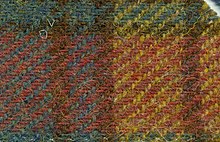Catherine Murray, Countess of Dunmore
The Countess of Dunmore | |
|---|---|
 | |
| Born | October 31, 1814 |
| Died | February 12, 1886 |
| Nationality | United Kingdom of Great Britain and Ireland |
| Occupation | philanthropist |
| Known for | supporting the people of Harris and Lewis with work |
Catherine Murray, Countess of Dunmore (31 October 1814 – 12 February 1886), was an English peeress and promoter of Harris Tweed.
Family[]
Born Lady Catherine Herbert at Arlington Street, St James's, London, she was a daughter of George Herbert, 11th Earl of Pembroke and his second wife, the former Countess Catherine Vorontsov, daughter of Semyon Romanovich Vorontsov, the Russian Ambassador to the Court of St. James's.[1]
On 27 May 1836, Lady Catherine married Alexander Murray, Viscount Fincastle at Frankfurt am Main. Fincastle acceded to his father's earldom of Dunmore a few months later. The couple had four children:
- Lady Susan Catherine Mary (1837–1915), married 29 November 1860 James Carnegie, 9th Earl of Southesk as his second wife, and had issue three sons and four daughters.
- Lady Constance Euphemia Woronzow (1838–1922), married William Buller-Fullerton-Elphinstone, 15th Lord Elphinstone.
- Charles Adolphus, styled Viscount Fincastle, later 7th Earl of Dunmore (1841–1907)
- Lady Victoria Alexandrina, or Lady Alexandrina Victoria Murray (1845–1911), married Rev. Henry Cunliffe (1826–1894), son of Sir Robert Henry Cunliffe, 4th Bt. CB, Gen., Bengal Army.
Later life[]
In 1841, Lady Dunmore was appointed a Lady of the Bedchamber to Queen Victoria but resigned upon her husband's death four years later. Following his death, she inherited 150,000 acres (610 km2) of the Dunmore estate on the "island" of Harris.[1]
She made several improvements to the estate village, building a school and laying out a new village green.[2]
Harris Tweed[]

During the economic difficulties of the Highland Potato Famine of 1846–47, Lady Dunmore paid for her tenants to emigrate and gave them a grant to help them settle.[1] Together with "Fanny" Beckett she promoted Harris Tweed, a sustainable and local industry.[3] Recognising the sales potential of the fabric, she had the Murray family tartan copied in tweed by the local weavers and suits were later made for the Dunmore estate. Proving a success, Lady Dunmore sought to widen the market by removing the irregularities, caused by dyeing, spinning and weaving (all done by hand), in the cloth to bring it in line with machine-made cloth. She achieved this by organising and financing training in Alloa for the Harris weavers and by the late 1840s, a London market was established, which led to an increase in sales of tweed.
"Fanny" Beckett moved to London in 1888 and the "Scottish Home Industries" which managed the new product, became a limited company in 1896.[3]
Death[]
The Countess died, aged seventy-one, on 12 February 1886 at Carberry Tower, Inveresk, East Lothian, and was buried at Dunmore, Falkirk.
Arms[]
  |
|
References[]
- ^ a b c "Murray [née Herbert], Catherine, countess of Dunmore (1814–1886), promoter of the Harris tweed industry". Oxford Dictionary of National Biography (online ed.). Oxford University Press. 2004. doi:10.1093/ref:odnb/47198. Retrieved 22 December 2020. (Subscription or UK public library membership required.)
- ^ Scott, Ian. "Dunmore near Airth". Falkirk Herald.
- ^ a b Lodge, Christine (2004). "Beckett [née Bousfield; other married name Thomas], Frances Sarah [Fanny] (bap. 1821, d. 1902), philanthropist and a founder of Scottish Home Industries". Oxford Dictionary of National Biography (online ed.). Oxford University Press. doi:10.1093/ref:odnb/56317. ISBN 9780198614128. Retrieved 22 December 2020. (Subscription or UK public library membership required.)
- ^ Debrett's Peerage. 1839.
Sources[]
- Christine Lodge, Murray , Catherine, countess of Dunmore (1814–1886), Oxford Dictionary of National Biography, accessed 26 Oct 2007
- 1814 births
- 1886 deaths
- Scottish countesses
- Daughters of British earls
- English people of Russian descent
- Ladies of the Bedchamber
- Herbert family
- 19th-century British women
- 19th-century British people
- 19th-century British philanthropists
- Court of Queen Victoria